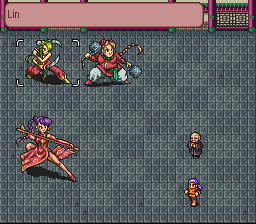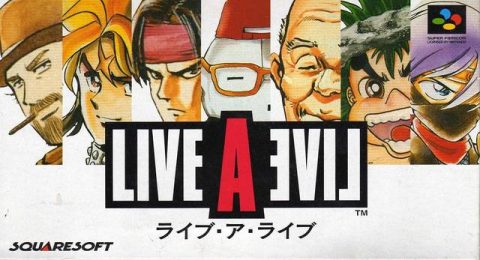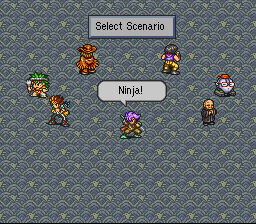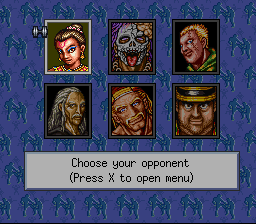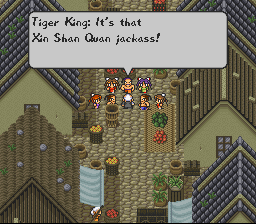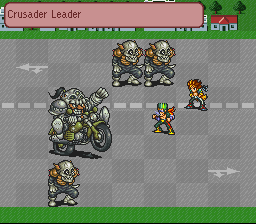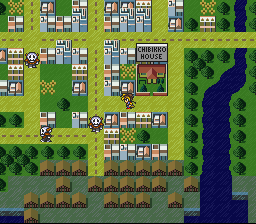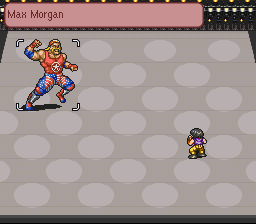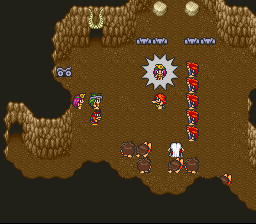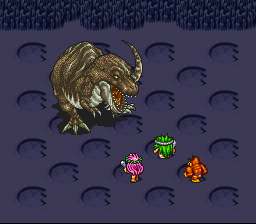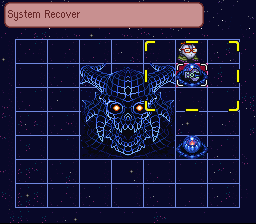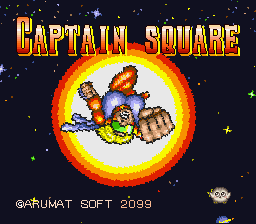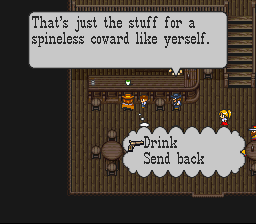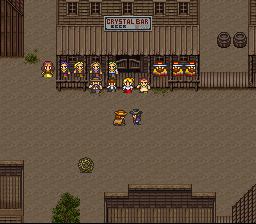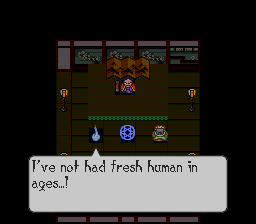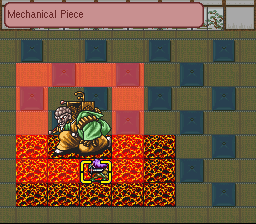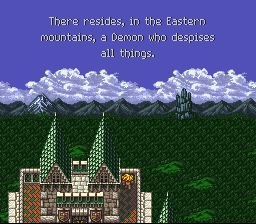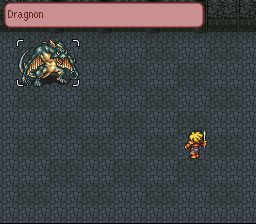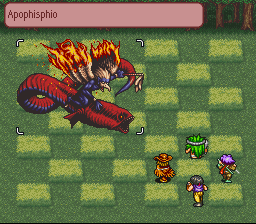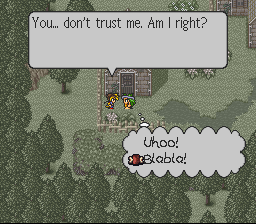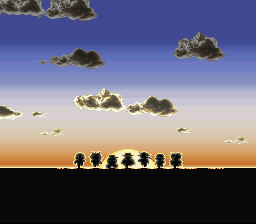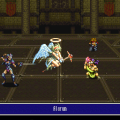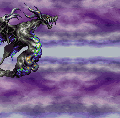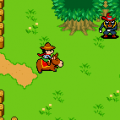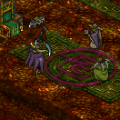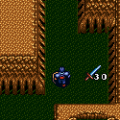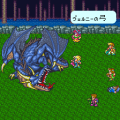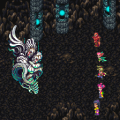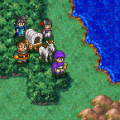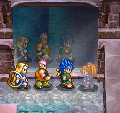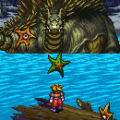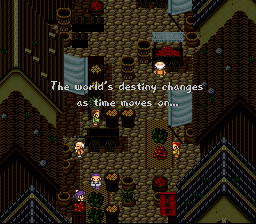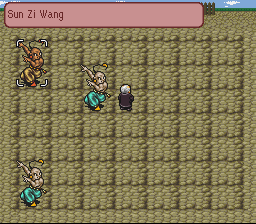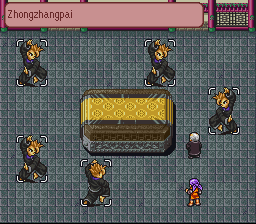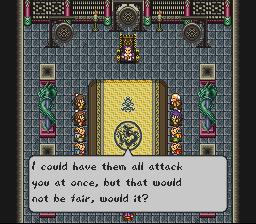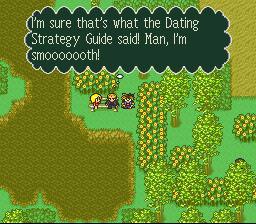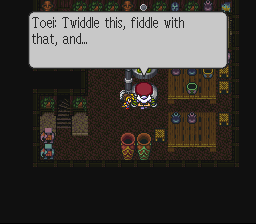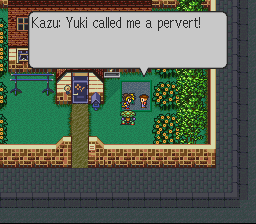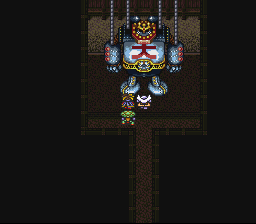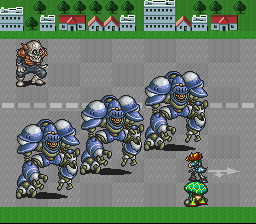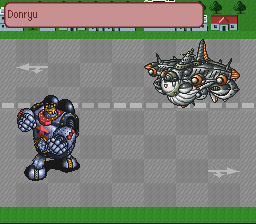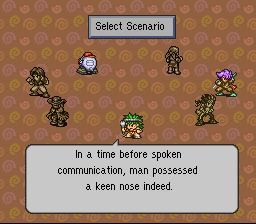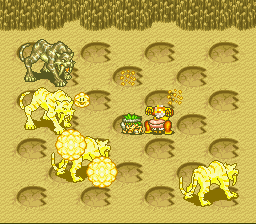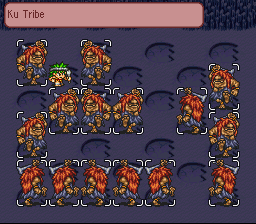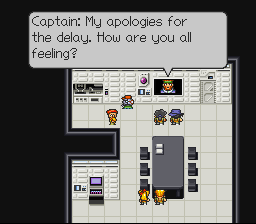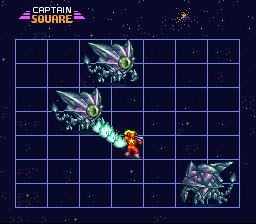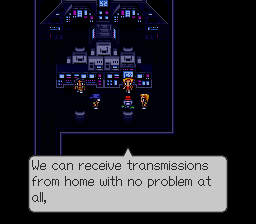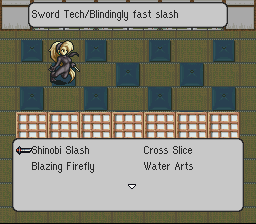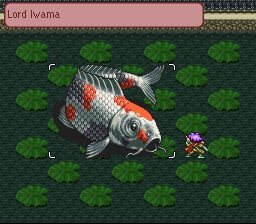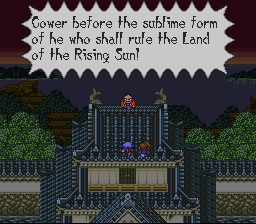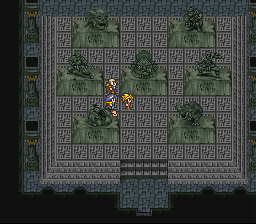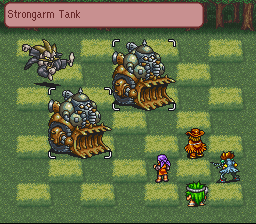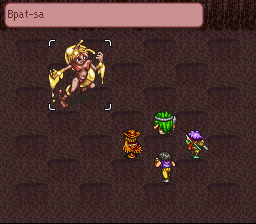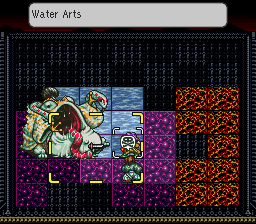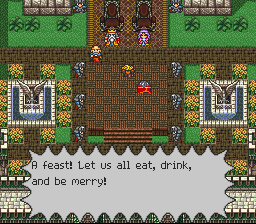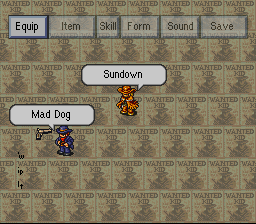It’s a clever gameplay mechanic: have a bunch of heroes individually fight through their own chapters of a video game, and maybe have them come together for a final quest at the end. However, it’s hardly unique to Live-A-Live, and Live-A-Live wasn’t necessarily even the first: see for instance Romancing SaGa, Dragon Quest IV, or Phantasy Star III.
Live-A-Live‘s big twist on the formula is that its heroes, rather than co-existing in the same world, each hail from radically different time periods. The result is almost like a little game anthology: while the same battle system is used throughout the game, each of the game’s episodic chapters features a different approach to game design, with its own largely self-contained storyline, gameplay gimmick, and graphic artist. Some of the chapters consequently work much better than others, and a lot of the game’s charm rises from the contrasts between them. None of them are really long enough to quite achieve the same lofty emotional resonance of more prominent RPGs, but on the flip side, the chapters you may not like as much are at least over with quickly.
The graphic artists for each chapter are all quite well known for their manga work, and their names are prominently displayed at the start of each chapter and in the game’s credits, but unless one already has some familiarity with their work, the difference between the graphical styles of each chapter isn’t particularly stark. There’s also some big-name talent from Square involved, including Takashi Tokita, who had just previously served as lead designer for Final Fantasy IV at the time the game was developed. The game’s composer is Yoko Shimomura, who is better known today for creating the music for Super Mario RPG and Kingdom Hearts.
For many years, Live-A-Live was playable through a translation patch courtesy of Aeon Genesis, but while quite functional, the patch did nothing to enhance the game’s already somewhat lackluster presentation. In 2008, a much improved “Deluxe” translation patch was released, with an improved translation, a variable-width font for the menus, and even a unique font for the text of each chapter. It is this “Deluxe” translation that is featured in the screen shots here.
Unifying the game’s chapters is Live-A-Live‘s distinctive battle system, which is almost like a turn-based strategy game along the lines of Final Fantasy Tactics or Treasure Hunter G. Confined as it is to a 7×7 grid, at its best it almost comes across as something like a game of chess. Each character’s attack can be wildly different in the areas of the grid it can target, and the same goes for the enemies, meaning that success is sometimes a matter of carefully positioning one’s characters so they can strike most effectively while still being able to avoid an enemy’s stronger attacks. Navigating the menus at each turn can be a bit bothersome, but you can easily bring up the last-executed attack by pressing X.
Alas, it doesn’t quite work as well in practice. Rather than bogging the player down with statistics about charge times and movement limits, most of the mechanics of the battle system are completely hidden from the player. For instance, you might want to move your characters out of the way once they get hit, but you have no way of knowing how far they’ll be able to move before an enemy can attack again. Charge times (that is, the amount of other battlefield actions that might take place between when an attack is selected and when it is actually executed) also vary widely, to the point where you might even find the action of bringing up an attack menu to be interrupted by one of your other character’s attacks. Fortunately, the difficulty of the battles is rarely so harsh (particularly since you’re automatically healed after each battle) that you’ll find yourself frustrated by minutiae of the mechanics.
Although the different time periods featured might be a little cliché, seeing them depicted in the form of a sprite-based RPG nonetheless gives them a refreshing appeal. The only obvious recurring characters are a young man named Watanabe and his father, who provide a sort of dark comic relief: usually they show up for just long enough for Watanabe’s father to be killed somehow. The other connection is too ingeniously subtle to reveal here. The first seven chapters can be completed in any order, and until the final chapter is unlocked, you can even go back and replay them.
Kung Fu Chapter: “Inheritance”
The Kung Fu chapter is very much a typical Wuxia tale. The protagonist is an aging martial arts master seeking to pass on the secrets of his fighting style, Xin Shan Quan, to a new disciple. The hook in this chapter is that in the end, depending on your actions, one of three possible characters will emerge as the new master of Xin Shan Quan: the stout Sammo, the brash theif Li, or the small but wise Yuan.
Unfortunately, aside from the hook, the Martial Arts chapter is really rather dry, featuring numerous repetitive training fights followed by a lengthy set of scripted battles. The finale, with an old-fashioned tournament ladder strewn with the boss’s underlings, isn’t quite clever enough to save it.
Near Future Chapter: “Flow”
The Near Future chapter is largely the turkey of the bunch. The protagonist in this case is Akira, a teenager with psychic powers who lives at an orphanage. Akira’s town is being terrorized by a gang of bikers, and is also being subjected to a series of mysterious kidnappings. And then there’s the giant Babylonian robot secretly kept by an antique dealer friend of his, who also changes a dying pet turtle belonging to Akira’s sister into an android. The plot ultimately degrades into a rather muddled mess incorporating the military, soul-amplifying drugs, and some bizarre nonsense about “liquefied humans”, the sort of thing you might find in a particularly low-grade anime series.
Even if you happen to like low-grade anime plots, making the chapter even more unforgivable is its general gameplay structure, which falls victim to the absolute worst kind of JRPG design. Frequently the plot just won’t advance until you go somewhere and talk to someone and do something utterly inconsequential for no apparent reason. The problem is further exacerbated by Akira’s special ability, which allows him to read people’s minds when you press the Y button – meaning that not only do you have to go around and do random things and talk to random people to advance the plot, but you sometimes have to semi-randomly read their minds as well. Add in the fact that the poorly-drawn world map, which you’ll be tempted to scour repeatedly in attempting to advance the plot, is crawling with biker battles and the result is something that should have been sent back to the drawing board.
The chapter’s sole redeeming feature (aside from the rather catchy music, at least) is that in the end, you do end up fighting a series of battles in the form of that giant mecha, the Buruki Daioh, an awesomely overpowered behemoth capable of stomping all over armies of tiny tanks and airplanes. Unfortunately, it’s not nearly enough.
Present Day Chapter: “The Strongest”
The Present Day chapter takes things right back to basics: it’s a fighting game, with no RPG elements to speak of. Masaru is setting out to become the world’s strongest fighter, and to do so, he’s going to take on (in any particular order) the world’s six strongest fighters: the usual rogue’s gallery of an old man, a wrester, an army guy, and so on. The chapter is laid out much like any typical fighting game, complete with a training montage introduction, winning and losing quotes, and even a countdown clock in the style of Street Fighter II if you’re defeated.
Since the chapter consists entirely of a set of battles, the fights are vaguely more strategic than usual, and knowing where to safely stand so you can restore your HP (using the “Battle Cry” command) can be important. Each of Masaru’s opponents has two unique attacks that become available to Masaru provided that he’s attacked by them, so the general object in each fight is to stay alive and pressure the enemy into using his moves. Since some of the learned moves are more versatile than others, taking on the opponents in the right order can make things somewhat easier. On the whole, it’s all a little more frustrating than satisfying, but the chapter is over with fairly quickly, so it is of little consequence.
Prehistoric Chapter: “Contact”
The Stone Age chapter features Pogo, a young caveman coming of age, and his monkey pal. Pogo falls in love with a mysterious young woman, and in the process aggravates an intertribal war. Pogo’s time is depicted as predating speech; the most you’ll see is the occasional comic-like bubble bearing some kind of iconography. The chapter is a powerful testament to the ability of 2D sprites to convey a meaningful emotional story, even if it’s not always perfectly clear exactly what’s going on. There’s also a good deal of humor, which might be expected when one of the characters is a farting monkey that can attack by throwing poo, and another one, the chief warrior of the opposing tribe, is a bizarre narcissistic guy who wears nothing but a lizard.
Game-wise, the Stone Age chapter is one of the more sophisticated and open-ended ones. It’s the only one with anything like a shop, taking the form of a barter system whereby you can trade in different combinations of items won in battle (hides, horns, sticks, rocks, and such forth) for new and better items. In practice, unfortunately, this system amounts to combining everything you get with everything else and hoping you don’t lose something rare along the way. You’re also free to wander the land and engage in battles as much as you want. Rather than random encounters, Pogo finds animals with his powerful sense of smell; pressing Y causes clouds to appear on the screen, representing scents that can be tracked to initiate battles, or in some cases to advance the larger plot.
Science Fiction Chapter: “Mechanical Heart”
To balance out the Present Day chapter, the Science Fiction chapter features no conflict at all aside from the last boss encounter. In this case the protagonist is Cube, a basic, silent worker robot brought to life on the starship Cogito Ergosum as it returns to Earth. Amongst its crew members are a curiously distant captain, a pretty young woman caught in a love triangle, and a brash military type responsible for a vicious-looking alien life form in the ship’s cargo hold. The stage is thus set for pretty much every sci-fi horror movie cliche to slowly wreak havoc.
It might sound a little dull, but the Sci-Fi chapter is something of a triumph in design. The ship’s interior owes a lot to the first Alien movie. There’s generally very little music (aside from an appropriately ominous theme that plays on occasion), and the ambient sounds do an excellent job of conveying the ship’s empty isolation as you race the helpless Cube up and down corridors. There are a few occasions where it’s not quite clear what you’re supposed to be doing (aside from panicking), but the ship is small enough that it’s usually not much of a problem, aside from a few occasions where, bafflingly, the only way to progress is to start serving coffee.
If you get bored with the adventuring, there is a short series of battles available via an arcade game on this ship, amusingly entitled Captain Square. Not unlike the Present Day battles, they’re rather strategic and it can be quite a challenge to make it to the end, but fortunately there’s no impact on the story if you get too frustrated with it to bother finishing.
Old West Chapter: “Wandering”
The Sundown Kid, a price on his head, happens to mosey into a town terrorized by the vicious Crazy Bunch. The Sheriff being a cowardly fellow, it’s up to the Kid and Mad Dog, his old rival, to save the day. It’s not a long chapter, but the music, graphics, and NPC dialog do an excellent job of setting up an atmosphere akin to an old Western film.
The Old West chapter is yet another slightly odd concept that doesn’t work too well in practice. Once the introductory material is out the way, the Crazy Bunch is set to ride into town in a matter of “hours”, and the object is to run around all of the town’s buildings to find materials that can be used to set traps. Then you have to give the materials to the townspeople, huddled in the saloon, to set up appropriately, though some of them are better and faster than others. Alas, searching for items amounts to walking up to pretty much absolutely everything and tapping A, which gets kind of old, and in the end, it doesn’t amount to much of consequence anyway. If the gang members don’t get knocked out by traps, they’ll have to be dealt with alongside the final boss, but they’re sufficiently underpowered that even fighting them all at once isn’t much of a strain. It’s kind of amusing to watch them all successively fall victim Home-Alone style to the improvised traps, though.
Bakumatsu Chapter: “Secret Orders”
Set in the Bakumatsu era of Japanese history (think Last Blade), the Bakumatsu chapter is the story of Oboro, a Shinobi who has been charged by his clan with the task of infiltrating a castle and rescuing a prisoner. That’s pretty much all you know. And all you need to know, really.
It’s light on story, but otherwise the Bakumatsu chapter is the most intricate of them all. The castle is a huge, complex maze filled with clever traps and some challenging puzzles. The battles are unusually tough as well, with a strong focus on elemental attacks that you can turn to your advantage if you’re careful.
The chapter’s flaw is that it really goes too far: if you’re not obsessively going after 100% completion, it’s easy to miss a lot of stuff, including secret characters and hidden, ruthlessly difficult bosses. It doesn’t help that navigation is slightly more complicated than it needs to be; there are numerous cases when exits from a room ought to be a lot more obvious than they are. Fortunately, a lack of relentless thoroughness in this chapter is unlikely to impede you much later in the game.
For the obsessive types, there are actually two significant challenges available, neither of which you’ll probably ever have a chance of accomplishing without some sort of walkthrough. Oboro’s special ability lets him completely hide when you press the Y button, and if you’re scrupulously careful, you can actually make it through the entire chapter without killing any humans. (The various demons, ghosts, and mechanical contrivances are still fair game, though.) Alternatively, you can seek to kill all one hundred humans in the castle, a feat that might be as difficult, given how well-hidden some of them are.
Medieval Chapter: “King of Demons”
Live-A-Live finally returns to traditional JRPG territory here, or so it seems. The Medieval chapter is technically fantasy, but it’s quite refreshingly “low” compared to the typical JRPG realm. There are no elves or other fantastic magical creatures, per se, and while there’s one magician, all he’s good for is meting out damage spells. Rather than exotic potions being flung left and right, most of the healing items available consist of rather ordinary grasses.
Nonetheless, other elements are quite familiar. Oersted, a knight, wins a tournament and the hand of the princess, only for her to be rather promptly hauled off to a foreboding mountain by a winged demon, and the only chance of rescuing her is to set out to find the legendary hero who defeated the demon long ago. Making things even more familiar is that this chapter finally sees the return of standard random battles as you wander around the map.
It kind of goes without saying that, since the Medieval chapter only opens up once the other seven chapters are completed, Oersted’s quest is somehow linked to the fates of the other characters. What happens is called “some of the most memorable plot twists in all of RPG history” by the translator, and it’s best not spoiled here.
Final Chapter
It might seem unlikely given the chapters’ diversity, but yes, there is still a big chapter that unifies the game’s protagonists. The final chapter takes place in an empty, subdued version of the Medieval world, complete with the random battles. You begin by selecting one of the protagonists as your starting character; the others can be found, some more easily than others, by wandering around. In a truly brilliant little twist, trying to start the chapter as Oersted starts up a boss rush – except you get to control the boss of each chapter, and use its attacks to wail on drastically underleveled versions of the heroes!
Of course there’s a final boss to be confronted, but even though there aren’t really any NPCs to chat with, there’s a fair amount of optional activities in the final chapter. You’re free to level up as much as you want, and many of the characters develop pretty powerful attacks in the process. None of the characters are particularly terrible, but some of them are quite a bit more powerful than others. (Cube, ironically enough, is pretty handy, but pays for it by being unable to level up; boosting his HP requires the rather tedious collection of Power Parts, which are only dropped by certain enemies.) To keep things fresh, the random encounters automatically change as your levels increase; while some of the enemies you face are just palette swaps of enemies from each of the various chapters, there’s also a selection of decently freakish demons mixed in.
Each of the seven protagonists has his own special themed dungeon, the entrance of which can be cleverly concealed and which holds the respective character’s ultimate weapon. Like the chapters themselves, some of these dungeons work out better than others. For instance, Cube’s dungeon is just a series of rather crafty puzzles, while Oboro’s dungeon involves repeatedly running back and forth trying to trigger a random encounter with an enemy that will drop the keys necessary to progress.
Also not working out as well as it could is inventory management. There’s nothing really wrong with the inventory in each individual chapter, but at the end, between chests, item drops, and whatever items your characters have equipped on them, you can end up with a real mess. There’s really no easy way to tell if a given item can be equipped, who can equip it, and in which of the oddly numerous equipment slots it can be used, nor is there an easy way to determine what special features (like status immunities) an item may confer from the actual equip screen. Healing items are almost as bad – there’s no way to tell how effective a given healing item is until you actually try to use it in battle (but fortunately you don’t actually have to waste the item in the process). There are rudimentary optimization and sort functions available, but on the whole it’s pretty shabby.
Like so many JRPGs, Live-A-Live has its share of secrets that really no one would be remotely likely to ever find without a strategy guide. In the case of Live-A-Live, a limited edition of the strategy guide included a CD with two tracks of arranged music: the Medieval theme, and a montage of the different battle themes. The Martial Arts theme and Medieval theme (again) were two of the arranged tracks featured on Drammatica: The Very Best of Yoko Shimomura. The game still has a sufficiently large following that a doushinji album, End of Justice, was released in 2006, featuring arranged dance-like interpretations of selections from the OST.
Live-A-Live gets a lot of things not quite right, but given how stagnant and cliche-ridden the JRPG genre can be at times, it’s very refreshing to see so much innovation in one package, and fortunately the things the game gets wrong don’t stand in the way of a decent gaming experience. Tokita has expressed some interest in remaking the game, possibly in the form of individually-downloadable episodes, so the world may not have seen the last of it.
Links:
RPGClassics Live-A-Live Shrine The only guide you’re likely to ever need for the game.
FantasyAnime’s Live-A-Live Page Featuring a selection of Japanese fan art.
